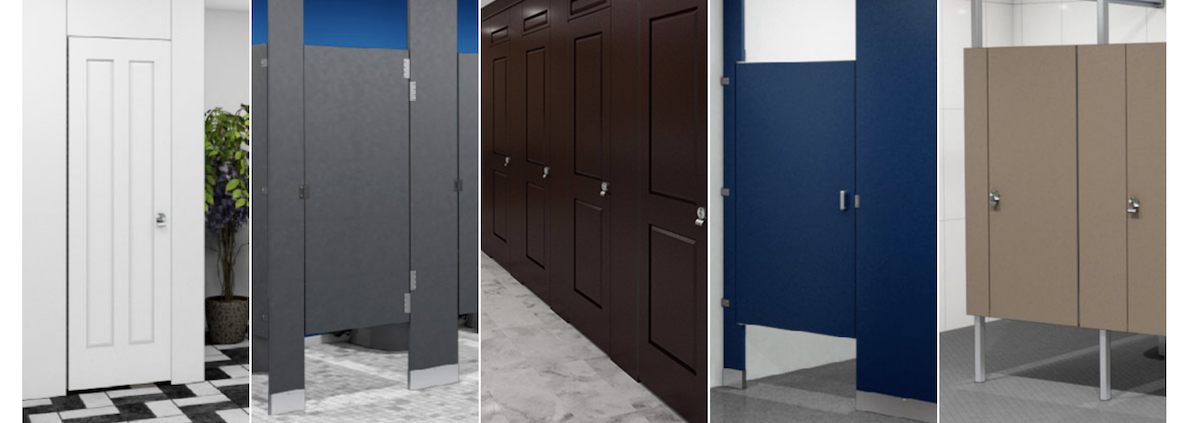How to Choose Commercial Bathroom Partitions for Virtually Any Facility
As a professional contractor or building administrator, you’re faced with a number of important decisions. When it comes to sourcing materials for bathrooms, you want to be sure the that materials you choose are durable, require little routine maintenance, and fit within your budget, which can be easier said than done.
So in this post, we’ll teach you how to choose commercial bathroom partitions for just about any facility, from schools to stadiums to office buildings and more.
Selecting Cost-Efficient Materials
One of the most important factors when choosing bathroom partitions is cost. There are many different materials available, with varying initial and long-term costs to consider. The five materials we’ll look at are enamel painted steel over paper, phenolic core, stainless steel, reinforced composite, and high-density polyethylene.
Baked Enamel Painted Steel Over a Paper Honeycomb Core
The most inexpensive of these is definitely baked enamel painted steel over a paper honeycomb core. This type of partition is frequently found in schools and office buildings because of its low initial cost. However, the life expectancy of enamel painted steel is extremely low given its propensity to rust when exposed to moisture.
Solid Phenolic (Black Core)
Solid phenolic core, sometimes referred to as black core because of its color, features a resin-impregnated kraft paper core. This material is very dense and composed of many compressed layers, similar to how fiberglass is created. However, this material may easily be damaged by scratches.
Stainless Steel
Many designers for high-end establishments and sports clubs favor stainless steel because of its clean and modern look. However, stainless still is also prone to rust and high costs, both initially and in terms of routine maintenance. Stainless steel partitions are also known to show smudges and fingerprints easily, making them harder to keep looking clean.
[READ MORE: Commercial Bathroom Trends]
Solid Color Reinforced Composite (SCRC)
You’ll commonly spot SCRC in high-traffic areas such as sporting arenas, schools, and train stations. This material is durable like black core partitions. The two biggest downsides to SCRC are the high cost, as it’s much more expensive than solid plastic or stainless steel, and its limited color options.
High-Density Polyethylene (HDPE)
HDPE is a type of solid plastic that’s perfect for use as commercial bathroom partitions. About 1 inch thick and solid color throughout, HDPE is highly resistant to graffiti, scratches, mold, mildew, and even bacteria. Given that this material is environmentally friendly and doesn’t negatively impact the indoor air quality, it’s a favorite for schools, medical facilities, and restaurants. It also requires little long-term maintenance.
Installation Types for Your Commercial Bathroom Partitions
Depending on the design of your commercial bathroom, there are four different methods for installing your bathroom partitions. The fastest and most economical option is to have the partitions floor mounted and overhead braced. This type of installation process works well with either wood or concrete floors and works by mounting the pilasters to the floor and the panels to the wall. An anti-grip aluminum headrail is positioned along the top of the partitions to offer additional support and stability.
If your bathroom has a low ceiling, you can choose to have them floor mounted only. This method requires at least 2 inches of concrete flooring in order for the pilasters to be mounted firmly. The panels are then mounted to the wall. The top of the partitions will be flush.
For a modern and unique look, or if the floors of your bathroom aren’t adequate for mounting, ceiling-hung partitions are a great option. You’ll need steel ceiling supports to withstand the weight and installation process. The pilasters are mounted to these supports, and the panels are mounted to the walls. One benefit of this installation method is that it makes the floor of the bathroom easy to clean.
[READ MORE: 9 Things to Consider Before Designing Your Commercial Bathroom]
The final installation method is floor-to-ceiling. In this scenario, pilasters are mounted to both the floor and the ceiling for maximum strength. It’s suggested that the facility have concrete floors and steel ceiling supports.
Choose an Eco-Friendly, Sustainable Material
When you choose high-density polyethylene (HDPE) materials from Scranton Products for your restrooms, lockers, and other interior applications, you’re supporting a healthier environment both inside and outside your facility. Our HDPE products help to reduce environmental impact and offer initial and long-term improvements to the indoor air quality of your projects.
Choose a Color That Compliments
The last step in choosing commercial bathroom partitions is selecting the color. Materials like HDPE come in a wide variety of colors and textures so you have plenty of options to choose from. You can either go with a shade that matches the interior of the bathroom or pick a different color that compliments the theme. Either way, you’re sure to be left with one terrific-looking bathroom.
Want more information about building a cost-effective bathroom? Download our eBook The Professional’s Guide to Commercial Bathroom Renovations and Remodels. This FREE resource is full of useful information that will teach you pro tips for choosing materials, how advances in materials are leading to more fluid designs, and which must-have amenities your commercial bathroom needs.




